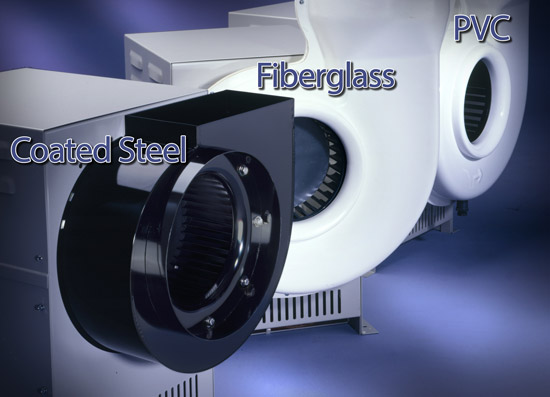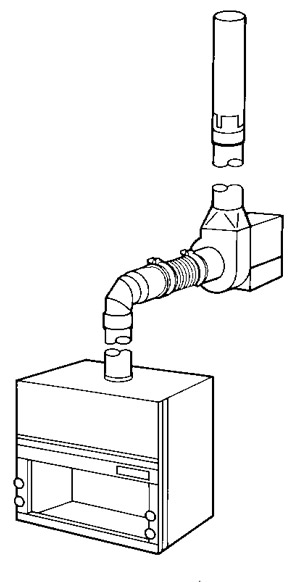Top 5 questions to ask before purchasing a fume hood blower
Certain products in a laboratory require a remote blower in order to operate. Choosing the correct blower makes a huge difference in how that piece of equipment performs. For example, if a motor with the wrong horsepower is chosen, it may not pull enough air through the fume hood to contain effectively, putting personnel at risk of breathing hazardous fumes – precisely what the fume hood was created to avoid!
Answer these five questions to make your blower choice an easy one:
 1. What blower construction materials do I need?
1. What blower construction materials do I need?
Three common materials for blowers are:
If you aren’t sure what type you need, a good rule of thumb is to match it with the fume hood liner material.
If the chemicals used in your applications are non-corrosive, such as Butane, a coated steel blower can be used. For moderately corrosive chemicals, such as Acetone, use a fiberglass blower. And for very corrosive chemicals, usually strong acids such as Hydrofluoric Acid, use a PVC blower.
2. How many operating speeds does my blower need?
Two very different types of blowers cover a wide range of applications:
- Belt-Driven (single speed)
- Intelli-Sense Multi-Speed Blower (up to three speeds)
The Belt-Driven Blower is good for laboratories that operate constant volume fume hoods. It is offered in coated steel, fiberglass, and PVC construction, and many of these models are offered in Explosion Proof (EP) construction.
The Intelli-Sense Multi-Speed Blower is good for small laboratories that are looking for energy efficiency. The largest operating expense for many laboratories is exhausting tempered air out of the fume hood. This blower was designed to alleviate the burden of those high energy costs. It can be programmed to operate at up to three different speeds using a control box located on top of the fume hood, making this blower incredibly versatile. A night set-back mode can be set to allow the fume hood to operate at low speeds, using the least amount of air required, when the fume hood is not in use, while still maintaining negative pressure within the fume hood to ensure back draft prevention. This blower is not available in EP construction.
3. Where should my blower be mounted?
Typically blowers are mounted on the rooftop so that the exhaust stack can be oriented vertically, allowing harmful fumes to exhaust and travel with higher elevation trade winds, carrying the vapors away from the surrounding environment.
Consider what is being exhausted and how it is being exhausted. For example, you would not want to allow acid vapors to flow over a parking lot, possibly harming vehicles below. Nor would you want the vapors to exhaust out of the side of the building if there is an air conditioning unit a short distance away.
Plan carefully to ensure that vapors are exhausted properly.

4. What should I consider when planning my ductwork?
The material and design of your ductwork are key to providing a safe exhaust system. The material of the ducting must be compatible with local fire codes, and also compatible with the chemicals your ductwork will be exposed to. The two most common types of duct are Type 1 PVC (great for use with corrosives) and 316 Stainless Steel (great for use with solvents). If you have both solvents and corrosives, you may have to make concessions based on the most aggressive chemicals used; however, Type 1 PVC is very versatile.
Accessories that may be added to your system include a damper to control airflow, flexible duct to reduce vibration, and a Zero Pressure Weathercap to exhaust the air vertically without stoppage. These are options that help the fume hood and blower operate at optimum levels.
With some applications, such as Acid Digestion or Perchloric Acid, ductwork may require a wash-down system in order to neutralize acid remnants. This will require a drain system connected to the hood and blower so that wash water can drain properly. Another consideration with these wash-down systems is to plan to run ductwork at an angle, not at a 0-degree horizontal, to allow water to easily wash down the system and drain into the fume hood’s drain trough.
5. How do I choose the right size of blower?
The relationships between static pressure, volumetric flow, and the RPM at which any blower can operate can be expressed by a blower curve chart. You could simply choose to leave the blower sizing up to a fume hood expert, but here is a basic run-down:
All fume hoods and ductwork systems create static pressure (or resistance), typically measured on an Inches of Water Gauge (in. w.g.) scale. The static pressure from all components is taken into account to ensure the blower can overcome the static pressure. The factors of a duct run include:
- Duct diameter
- Duct length
- Number of elbows and degree of bend (e.g. Two 90 degree elbows)
The velocity the fume hood is going to be operating at, and the corresponding sash height are also required pieces of information in order to size the blower most accurately.
After all of the information is compiled, all of the static pressure of the components can be added together and compared with the volumetric flow that matches the velocity. Then we can tell what blower will work with your fume hood.
Here is an example of a blower curve:
If your position is not within an available blower curve, a damper can fine-tune your operating position. The damper will create more static pressure, and lessen the volumetric flow of air (CFM).
Those are the top 5 questions to ask before purchasing a blower for a fume hood. For help answering any of these questions or for other information on fume hoods and blowers, you can contact me online, or call the Labconco at 1-816-333-8811.
![]()
Let Scout™ lead you to the right Labconco enclosure for your application.
| chevron_left | Brush up on safety tips specific to your biosafety level | Articles | How it works: Laboratory glassware washers protect your laboratory environment | chevron_right |







